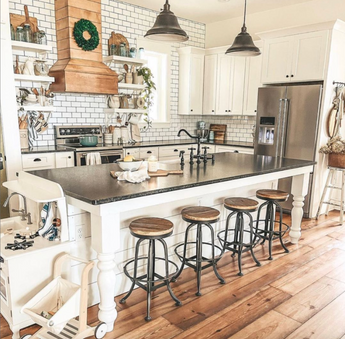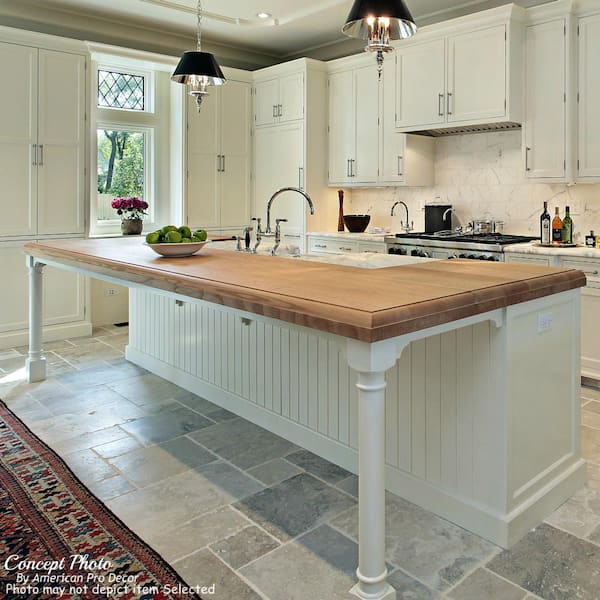The Top Kitchen Island Leg Styles to Enhance Any Layout Aesthetic
Wiki Article
Checking Out the Necessary Functions of a Cooking Area Island Leg for Your Culinary Room
The cooking area island offers as a central center in any type of cooking area, and the selection of leg style is pivotal in improving both its capability and aesthetic charm. Understanding the crucial attributes of cooking area island legs-- consisting of product alternatives, design styles, and security elements-- can significantly influence the general experience within the cooking area.Relevance of Kitchen Island Legs
Cooking area island legs play a critical role in both the capability and visual appeals of a cooking area room. They not only sustain the weight of the island however likewise improve the total design, adding to the kitchen's aesthetic allure. The option of legs can dictate the design of the cooking area, be it contemporary, traditional, or rustic.Functionally, durable and correctly made legs guarantee stability, permitting the safe usage of the island for numerous jobs such as cooking, dining, or amusing. Strong legs prevent tottering and shifting, giving a dependable surface area for day-to-day activities.
In addition, the elevation and placement of the legs can affect the comfort level for those seated at the island. A well-considered height can accommodate bar stools or chairs, promoting a welcoming setting for events.
In enhancement to these functional factors to consider, kitchen area island legs can offer as a focal point in the room (kitchen island leg). Attractive or distinctively created legs can elevate the layout visual, making the island a centerpiece. Thus, choosing the appropriate kitchen island legs is vital for balancing form and feature in any type of cooking area
Product Options for Legs
Choosing the ideal material for kitchen area island legs considerably impacts both toughness and style. Common product options include metal, stone, and wood, each offering unique advantages.Timber is a prominent selection due to its warmth and adaptability. It can be easily tailored to match different style styles, from rustic to modern. Woods like oak and maple give excellent toughness and long life, while softer timbers can be much more at risk to tear and wear.
Metal legs are preferred for their streamlined, modern visual. kitchen island leg. Stainless steel and aluminum are not only durable but likewise immune to corrosion and rust, making them suitable for kitchen environments. They can create an industrial look and are typically readily available in different coatings to complement various other kitchen area elements
Rock legs, such as granite or marble, add a component of deluxe and stability. While heavier than other materials, they provide exceptional durability and can stand up to substantial weight. Nevertheless, they might require extra assistance to make sure correct balance.
Inevitably, the selection of product ought to align with both functional requirements and the overall layout vision of the cooking area area, ensuring that the island legs enhance both energy and appearances.
Layout Styles to Think About
What layout styles should be thought about when choosing legs for a kitchen area island? The selection of leg style substantially influences the total aesthetic redirected here of your culinary area. For a contemporary cooking area, sleek and minimalistic leg layouts, such as stainless steel or geometric shapes, can improve the modern appeal, supplying a tidy and clean appearance.In comparison, conventional kitchen areas take advantage of timeless designs such as transformed or sculpted wooden legs, which add warmth and personality. These options often feature complex details that complement vintage home furnishings. For a rustic ambiance, consider legs made from redeemed timber or wrought iron, which bring an organic, earthy quality to the area.
If you lean towards a commercial motif, durable metal legs with a distressed finish may be suitable, giving an edgy yet innovative touch. In addition, farmhouse design kitchens can integrate chunky legs that evoke a feeling of strength and homeliness.

Elevation and Security Variables
The height and security of a kitchen area island are crucial aspects that straight influence its functionality and individual experience. An ideal kitchen area island leg must provide sufficient height to accommodate a variety of jobs, from food prep work to casual eating. Generally, kitchen islands stand between 36 to 42 inches tall, aligning with common counter and bar heights. This array ensures comfort for customers while executing numerous tasks, therefore boosting the total usability of the area.Stability is just as vital, particularly as cooking area islands typically work as prime focus in culinary atmospheres. A secure leg design reduces shifting and tottering, which can bring about mishaps or discomfort during use. Products such as solid wood, steel, or a combination thereof are frequently utilized to achieve the required strength. Furthermore, the leg's add-on to the island's read base have to be safe, ensuring durability and resilience against the damage of everyday usage.
Modification and Accessories
Modification choices and accessories for cooking area island legs can significantly improve both the visual allure and functionality of the room. Home owners can choose from a selection of materials, including steel, wood, and stone, permitting seamless integration with existing kitchen area decor. The choice of finish-- be it a natural discolor, paint, or powder coating-- more customizes the appearance, making certain that the island enhances the overall layout style.In enhancement to product and finish, house owners may also explore the consolidation of accessories such as ornamental brackets, adjustable feet, or incorporated shelving. Braces can supply additional assistance while contributing to a contemporary or rustic visual. Adjustable feet are particularly useful for unequal floor covering, making certain the island stays stable and degree, which is crucial for both security and use.

Final Thought
To conclude, cooking area island legs serve a vital role in offering stability and improving the total visual of the cooking space. The selection of materials and style styles adds to both performance and visual appeal, while factors to consider of height and security make certain practical usage. Customization alternatives and devices can elevate the kitchen island, making useful content it a distinct focal point within the home. Hence, mindful factor to consider of these functions is necessary for an effective cooking area design.The cooking area island serves as a central hub in any type of cooking area, and the option of leg layout is pivotal in boosting both its performance and aesthetic allure. Comprehending the important features of cooking area island legs-- consisting of product alternatives, style styles, and security variables-- can dramatically impact the overall experience within the kitchen area.Cooking area island legs play a crucial function in both the capability and aesthetics of a kitchen area space.What style styles should be considered when picking legs for a kitchen island?In verdict, cooking area island legs offer a vital duty in providing stability and boosting the overall aesthetic of the culinary space.
Report this wiki page